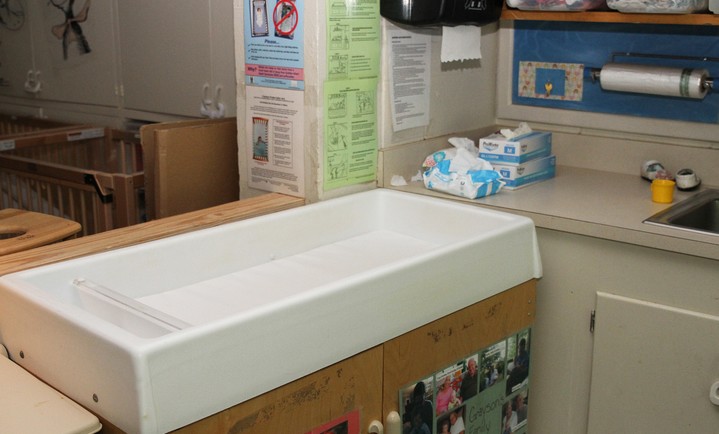
Diaper changes are an important part of caring for infants and toddlers. But diaper changing can also be a source of spreading germs if child care providers are not careful. To prevent the spread of germs, child care providers need to set up a clear procedure for diapering, and follow that procedure with every diaper change. Here are some tips for keeping the diaper area clean and changing diapers safely.
Setting Up the Diaper Area
Use one central place for changing diapers, preferably near a sink. Have a specific changing table, counter, or other designated surface for diaper changing. Be sure the changing area is set up so you can still supervise the other children while changing a diaper.
- Choose a nonporous surface. The surface of the changing area needs to be nonporous so it can’t absorb any contaminants (no seams, quilting, cloth belts, or cracks) and can be thoroughly cleaned and disinfected. An example would be a hard plastic or laminate like a countertop.
- Select a surface with a raised edge. This will help keep the children from falling off. A raised edge of 6 inches is ideal.
- Store all diapering supplies and extra clothing in the area, but not on the diapering table. You will need diapers, disposable wet wipes, plastic bags for soiled clothing, extra clothing, a spray bottle with soap and water and one with bleach solution or other disinfectant, disposable paper towels, and a covered, plastic-lined trash container. Store these items off the actual diapering table, but within arm’s reach.
- Avoid changing diapers on the floor. Babies often wiggle off disposable coverings. It is very difficult to keep the floor free from contamination. This is especially important for other children who sit or crawl on the floor.
- Keep the diapering area separate from all food preparation areas. Germs from the changing table can infect food and utensils and spread illness. The diapering area should never be used for food preparation, storage, or drying dishes. Some child care programs recommend that different people be responsible for changing diapers and for serving food on any given day.
Diapering Tips to Avoid Spreading Germs
- Cover diapering surface with disposable paper. Paper towels, waxed paper, clean paper bags, or butcher paper are inexpensive choices for covering the diaper change surface.
- Remove all wet wipes from the container ahead of time. Do this before you undress the child to avoid contaminating the container.
- Have empty plastic bags ready. Use these for diapers and soiled clothing. Using empty bread bags or plastic grocery sacks will cut down on odors.
- Use disposable latex gloves, especially if the child has diarrhea or another illness. Many child care providers use gloves for all diaper changes.
- Always wipe from the front of the child to the back. Use a new wipe each time. Be sure to clean all cracks and creases in the child’s skin.
- Remove gloves by turning them inside out. Grab the middle of one glove with the other one and pull it off. Slide your ungloved hand inside the edge of the second glove and pull it inside out over the first glove. This will keep contamination inside the gloves and off your hands. Be careful not to touch the soiled glove with your bare hand.
- Remove gloves before putting on the clean diaper. This will prevent you from spreading germs back to the child.
- Use a covered, plastic-lined trash can with a foot-operated lid. Using your hands to open the trash contaminates the can and your hands and is an easy way to transmit germs.
- Limit handling of soiled cloth diapers. If reusable cloth diapers are used, put the soiled cloth diaper and its contents – without emptying or rinsing to prevent contaminating yourself – in a plastic bag or sealed plastic container to give to parents at the end of the day. Do not dump out diaper contents into the toilet. If the diaper has a waterproof cover, change both diaper and cover, and do not reuse the cover until it has been laundered.
- Wash and disinfect the diapering table after every use. Once the table is clean, disinfect by spraying the table with a solution of bleach and water, and allow it to stay on the surface for at least 2 minutes. Wipe clean with a paper towel. If the sink being used for hand washing also is used for food preparation or other purposes, it must be cleaned and disinfected with a bleach solution after each use.
Child care providers can reduce the spread of germs by keeping the diaper area clean and by following these diapering tips and guidelines every time you change a diaper.
For More Information
To learn more about changing diapers, including step-by-step instructions for changing diapers without spreading germs, check out 10 Steps to Change a Diaper in a Child Care Setting, or visit the eXtension Alliance for Better Child Care section on Diapering and Toileting in Child Care.
Photo by Diane Bales / CC BY http://creativecommons.org/licenses/by/2.0/
